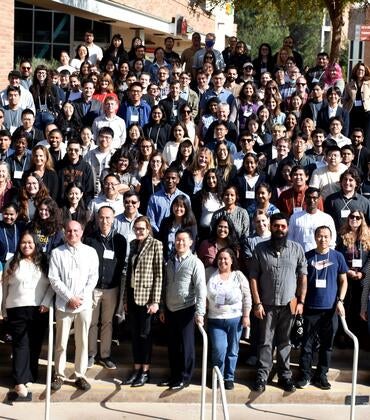Two scientists at UC Riverside have penned a perspective, by invitation from Science magazine, on a new research article authored by researchers at a British lab.
“Their work discovered a new isoform of Dicer enzyme that protects mouse and human stem cells from several RNA viruses like Zika and SARS-CoV-2 by enhancing antiviral RNA interference, or RNAi,” said Shou-wei Ding, a professor of microbiology and plant pathology, who wrote the perspective along with Shabihah Shahrudin, his postdoctoral researcher. An isoform is a protein that functions similarly to another protein, with possibly small differences in their sequences. A Dicer is a protein that trims double-stranded RNA molecules.
Ding explained that the RNA genome of viruses like Zika and SARS-CoV-2 mutates much faster than DNA genomes; generally, scientists know much less about immune mechanisms against RNA viruses than DNA viruses, he said. Using a Drosophila/fruit fly model, his lab was the first in 2002 to report a new antiviral immunity mechanism against the RNA virus in animals, which specifically destroys infecting viral RNAs by antiviral RNAi.
“The most critical component of this mechanism is the small-interfering RNAs, or siRNAs, that are cut out from replicating viral RNA genomes,” Ding said. “In response to the current COVID-19 pandemic, companies worldwide are testing siRNA cocktails as therapeutics to treat SARS-CoV-2, with one success in an animal model that was reported recently.”
Ding explained that the paper by the British lab scientists reports the discovery of an isoform of mouse and human Dicer that works more efficiently in antiviral RNAi than the one currently known and shows for the first time that infection with SARS-CoV-2 triggers the antiviral RNAi immune mechanism and produces the siRNAs targeting SARS-CoV-2, which are 22 nucleotides in length.
“The paper provides a list of the 22-nucleotide siRNAs made by the human Dicer during authentic infections to target Zika virus and SARS-CoV-2, which serve as candidates for therapeutics,” he said.
Ding added that antiviral RNAi is a new and important immune mechanism for the protection against human RNA viruses such as influenza, Zika, and SARS-CoV-2.
“The paper by the British lab scientists is an important one,” Ding said. “We note in the last paragraph of our perspective that siRNA therapeutics could be improved dramatically by considering the findings reported in their work as well as recent published studies from my lab and other labs.”
Shahrudin is supported by a grant to Ding from the National Institutes of Health to investigate antiviral RNAi in mammals.
The perspective is titled “Boosting stem cell immunity to viruses.”






